A word of caution: There are images that may be gruesome.


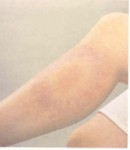
The simplest closed wound is a bruise or also known as a contusion. The discolorization of the skin is from blood underneath the dermal area. Also noticable is swelling (edema) and pain. The internal bleeding is caused by a blunt force damaging the tissue.
If there is heavy internal bleeding, signs of restlessness and shock symptoms may appear.
Shock occurs when blood pressure decreases. The heart thinks it needs to pump harder to spread oxygen but, it is pumping more blood out of the body.


Abrasions are commonly known as scrapes. It is a common open wound that is characterized by skin that has been torn away. Bleeding is not severe, yet nerve endings are exposed which cause much pain.
 Infection can result if wounds are not properly cleaned and cared for.
Infection can result if wounds are not properly cleaned and cared for.
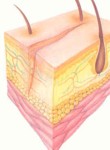
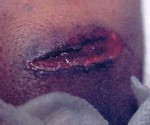
A laceration is a cut from a sharp object. A strong, blunt force may also cause the skin to split. Because deeper layers of the skin are injured, profuse bleeding may occur. Damage to nerves may prevent the sensation of pain.
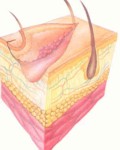

An avulsion results from having a portion of the skin torn away. Bleeding is usually heavy since deep tissue are often affected and those areas have arteries feeding the dermal tissue.
If there is heavy bleeding, stop it before the body goes into shock (hypoperfusion) or oxygen does not reach the brain. Both can lead to death


A puncture wound results when the skin is pierced by a pointed object. External bleeding may not be severe, while internal bleeding may be. Major blood vessels or organs may be affected.

 An objects that remains inside of a wound are called embedded objects. These types of injuries do not bleed profusely, but they can easily become infected. Objects usually carry microorganisms on them and create an entrance-way into the body.
An objects that remains inside of a wound are called embedded objects. These types of injuries do not bleed profusely, but they can easily become infected. Objects usually carry microorganisms on them and create an entrance-way into the body.

Stitches are the sewing or the stapling together of the skin. This speeds up the healing process, decrease the chance of infection, and improve the look of scars.
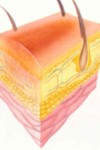

A superficial burn is also known as a first degree burn.
It involves only the top layer of the epidermis. Usually people with sunburn have a first degree burn.

 A partial thickness burn is known as a second degree burn.
A partial thickness burn is known as a second degree burn.
Both the epidermis and the dermis are affected. The area affected will usually appear red, blistered, and painful. The wound may heal within 3-4 weeks and is susceptible to infection.


A full-thickness burn is known as a third degree burn.
Both layers of the skin are severely damaged. These burns may appear black with the underlying tissues appearing white. Depending on whether the nerve endings are destroyed, it may or may not be painful. These wounds may be life threatening. The body is left open, fluid is lost, and shock may occur. The body is highly prone to infection. Many burn victims require skin grafts.
An electrical burn may appear black. Look for 2 wounds; an entry and an exit wound. DO NOT USE WATER! Instead cover the wounds with dressing.

The Rule of 9 method was created to assess the amount of damage done to the body. The body is divided into segments of 9%.
There are 3 different types of splints to immobilize a bone or joint injury.
Soft
Rigid
Anatomical